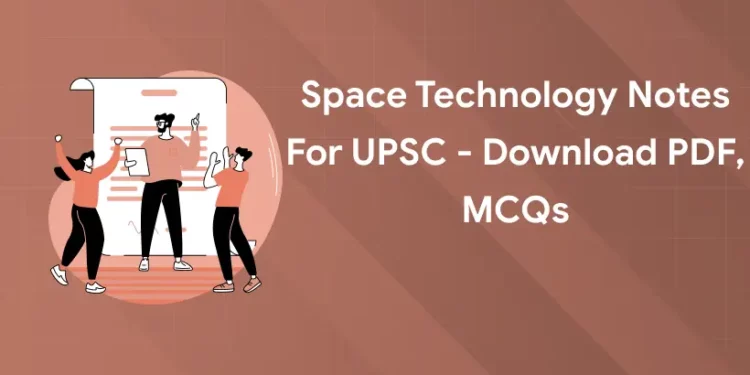Table of Contents
Space Technology has become an important factor in the development and security of the country, making it an important subject for UPSC aspirants. The Indian Space Research Organization (ISRO) has been at the forefront of India’s space efforts, contributing to various sectors such as communication, navigation, meteorology, etc. This blog provides a detailed, attention-grabbing overview of space technology decide how it applies to the UPSC exam.
Space technologies are technologies used in transportation or activities beyond Earth’s atmosphere, for purposes such as space travel or spaceflight. Space technologies include spacecraft, satellites, space stations and orbiting launch vehicles; long-distance communication in space; running in space; and a wide variety of new technologies including supporting tools and techniques.
Crack UPSC Exam with Expert Mentors! Get Free Demo Classes Here!
Space is such a novel environment that new tools and techniques are often required to try and work within it. Many everyday tasks commonly used on earth such as weather forecasting, remote sensing, satellite navigation systems, satellite television, and some remote communications systems rely heavily on spacecraft Among the sciences, astronomy and geoscience benefit from space technology. New technologies introduced or accelerated by space-related efforts are subsequently often applied to other economic activities.
- Milestones in India’s Space Programme
- What is an Orbit?
- Lagrange points
- Satellite
- List of Earth Observation Satellites
- Satellite Launching Vehicles
- Recent launches
- NAVIC
- NISAR
- GAGANYAN
- Project NETRA
- BHUVAN 3.0
- MASS ORBITER MISSION
- Mission Shakti
- Seven mega missions by ISRO
Space Technology UPSC Notes – Download PDF
Space Technology Notes
1: Which one of the following is not a Harappan site?
UNIVERSE
- All existing matter & space
- It consists of both physical (subatomic particles like electrons, protons to galactic super-clusters) and non-physical (light, gravitation, space etc.) components
- The universe, at present, is said to possess about 100 billion galaxies, each comprising an average of 100 billion stars.
BIG BANG THEORY
- Prevailing cosmological model for the birth of Universe
- It states that 13.8 billion years ago, all of space was contained in a single point of very high- density and high-temperature state from which the universe has been expanding in all directions ever since
Big Crunch (Death of Universe )
At some point, the universe would reach a maximum size & begin collapsing. The universe would become denser & hotter again, ending in a state like that in which it started — a single point of very high density
DOPPLER – SHIFT OR REDSHIFT
- Phenomenon that occurs when light waves are stretched, causing them to appear redder in This happens when an object emitting light is moving away from the observer
- Hubble’s Law states that the farther a galaxy is from us, the faster it appears to be moving away from us
CMD
- Cosmic Microwave Background
- Relic radiation (thermal radiation left over from the “Big Bang”)
- Oldest light in the Universe and can be found in all directions
- Its discovery is considered a landmark proof for the concept of “accelerating expansion of the universe” and the Big Bang Theory
GRAVITATIONAL WAVES
- Gravitational waves are ripples in the fabric of spacetime caused by the movement of massive objects, such as black holes or neutron stars
LIGO
- Laser Interferometer Gravitational-Wave Observatory
- Scientific experiment designed to detect and study gravitational waves
- LIGO consists of two identical observatories, located in Livingston, Louisiana and Hanford, Each observatory contains a pair of long, L-shaped tunnels
IndIGO
- Indian Initiative in Gravitational-wave Observations, is an initiative to set up advanced experimental facilities for a multi-institutional Indian national project in gravitational-wave astronomy
- LIGO-India is envisaged as a collaborative project between a consortium of Indian research institutions and the LIGO Laboratory in USA, along with its international partners
GRAVITATIONAL LENSING
- Gravitational lensing is a phenomenon that occurs when the light from a distant object, such as a star or a galaxy, is bent and distorted by the gravitational pull of a massive object, such as a black hole or a galaxy cluster
- Gravitational lensing is a powerful tool for astronomers to study the distribution of matter in the universe, including the dark matter that cannot be directly observed
STARS – LIFE CYCLE
- Coronal Paradox – Corona , outermost layer of the Sun’s atmosphere, is much hotter than its surface
- Coronal Mass Ejections – Powerful eruptions of plasma and magnetic field from the Sun’s corona
- When a CME is directed towards the Earth, it can have significant impacts on our planet’s environment and technological Infrastructure
- The ejected plasma and magnetic field can interact with the Earth’s magnetic field, causing geomagnetic storms that can disrupt satellite and power grid operations, radio communications
- Sunspots – dark regions that appear on the surface of the Sun. They are caused by strong magnetic fields that suppress the flow of heat from the Sun’s interior to its surface, resulting in cooler and darker areas on the Sun’s Surface
GOLDILOCKS ZONE
- Habitable zone, around a star where conditions are just right for liquid water to exist on the surface of a planet
- Area around a star where the temperature is just right for liquid water to exist on a planet’s surface
Space Technology – UPSC MCQs
Space Technology – UPSC MCQs PDF
1. Which of the following is India’s first satellite?
- a) Bhaskara-I
- b) INSAT-1A
- c) Aryabhata
- d) Rohini
Answer: c) Aryabhata
2. The Polar Satellite Launch Vehicle (PSLV) is used for launching satellites into which type of orbit?
- a) Geostationary Orbit
- b) Low Earth Orbit
- c) Polar Orbit
- d) Sun-Synchronous Orbit
Answer: d) Sun-Synchronous Orbit
3. Which Indian mission was the first to reach Mars?
- a) Chandrayaan-1
- b) Mars Orbiter Mission (Mangalyaan)
- c) Gaganyaan
- d) Astrosat
Answer: b) Mars Orbiter Mission (Mangalyaan)
4. What is the primary objective of the Chandrayaan-2 mission?
- a) To land a rover on the Martian surface
- b) To explore the Moon’s south pole
- c) To study the Sun’s corona
- d) To establish a space station
Answer: b) To explore the Moon’s south pole
5. Which of the following satellites is dedicated to Indian regional navigation?
- a) INSAT-3D
- b) GSAT-11
- c) IRNSS/NavIC
- d) Cartosat-2
Answer: c) IRNSS/NavIC
6. Which of the following launch vehicles is primarily used by ISRO for launching heavier payloads into geostationary orbit?
- a) PSLV
- b) GSLV Mk II
- c) GSLV Mk III
- d) ASLV
Answer: c) GSLV Mk III
7. What does the term “Gaganyaan” refer to in India’s space program?
- a) A satellite communication system
- b) A human spaceflight mission
- c) A lunar exploration mission
- d) An Earth observation satellite
Answer: b) A human spaceflight mission
8. Which space observatory, launched by ISRO, is dedicated to multi-wavelength astronomy?
- a) Cartosat-3
- b) Chandrayaan-1
- c) Astrosat
- d) GSAT-6A
Answer: c) Astrosat
9. Which of the following is the name of India’s upcoming mission to explore Venus?
- a) Aditya-L1
- b) Mangalyaan-2
- c) Shukrayaan-1
- d) Chandrayaan-3
Answer: c) Shukrayaan-1
10. Which of the following satellites is primarily used for Earth observation?
- a) GSAT-7
- b) RISAT-2B
- c) INSAT-3A
- d) NavIC
Answer: b) RISAT-2B
11. Which ISRO mission discovered water molecules on the Moon?
- a) Chandrayaan-1
- b) Chandrayaan-2
- c) Mangalyaan
- d) Aditya-L1
Answer: a) Chandrayaan-1
12. The Indian Regional Navigation Satellite System (IRNSS) is also known as:
- a) NavIC
- b) GLONASS
- c) Galileo
- d) Beidou
Answer: a) NavIC
13. Which ISRO program focuses on the development of reusable launch vehicles?
- a) Gaganyaan
- b) RLV-TD
- c) Chandrayaan
- d) Mangalyaan
Answer: b) RLV-TD
14. Which of the following is the primary aim of the Aditya-L1 mission?
- a) Mars exploration
- b) Lunar exploration
- c) Solar observation
- d) Deep space exploration
Answer: c) Solar observation
15. Which of the following countries collaborated with India on the Chandrayaan-1 mission?
- a) Russia
- b) USA
- c) France
- d) Japan
Answer: b) USA
Ace your Preparation for UPSC Exam! Enroll Here!
UPSC Calendar 2025
The UPSC Exam Calendar 2025 has been released by the Union Public Service Commission (UPSC) for all the exams conducted by UPSC for the financial year 2024-2025. The detailed examination schedule for all examinations has been updated through the examination calendar. Candidates should know the updated examination calendar for the posts of Civil Service, Indian Forest Service (IFS), NDA- NA I & II, CDS I & II, Engineering Services and Joint Geological, ISS , IES, CAPF , and other tests for recruitment of qualified candidates for various departments in Central Government.
UPSC Previous Year Question Paper 2025
CISF AC(EXE) LDCE-2024
| CISF AC(EXE) LDCE-2024 | |
| General Ability and Intelligence and Professional Skill | |
| Essay, Precis Writing and Comprehension |
Combined Geo-Scientist (Preliminary) Examination, 2024
| Combined Geo-Scientist (Preliminary) Examination, 2024 | |
| Paper – II Chemistry | |
| Paper – II Geology – Hydrology | |
| Paper – II Geophysics | |
| Paper – I General Studies |
Engineering Services (Preliminary) Examination, 2024
| Engineering Services (Preliminary) Examination, 2024 | |
| Paper – I General Studies and Engineering Aptitude | |
| Paper – II Electrical Engineering | |
| Paper – II Mechanical Engineering | |
| Paper – II Civil Engineering | |
| Paper – II Electronics and Telecommunication Engineering |












